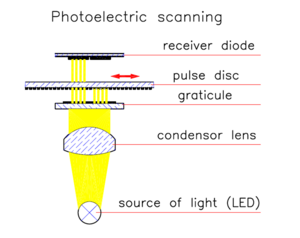Knowledgebase
Principle of Measuring
AMI encoders with optical scanning are manufactured with incremental graduations which are applied on to glass and/or etched in phosphorous bronze.
The information of a position is given by counting each increment, starting form a zero-pulse placed at an optical place, forwarded to the signal-operating electronic component. The zero-pulse ist determined by an additionally applied reference-marker.
The graduations applied are mainly manufactured in lithographic processes. This process allows very precise and exact sharply edged graduations. Combined with the photoelectric scanning method and a modern analysis of electronics a high quality of signals can be reached.
Accuracy
Major points in determining accuracy are:
_accuracy in graduation of pulse-disc and scanning board
_accuracy in rotation of bearing of shaft for pulse disc
_centering of pulse disc
_malfunctions/failures arising by connecting the encoder with coupling
In general with encoders a non-accuracy of +/- 1/20 graduation range can be assumed.

Scanning
We are working with a photoelectric scanning procedure in our company referring to almost all encoders. Scanning is effected contact free and therefor no wear emerges. Even most precise pulses and or signal-periods are identified. The light of a LED interfuses a scan-board on which there is fixed a grid pattern.
If the on top placed pulse-disc starts to rotate light/dark positions are reproduced. The light-sensitive receiver on the electronic component converts these pulses in nearly sinus-like signals. On adequate preparation on the above both square wave or sinus signals on signal-output are available for the end-user.
